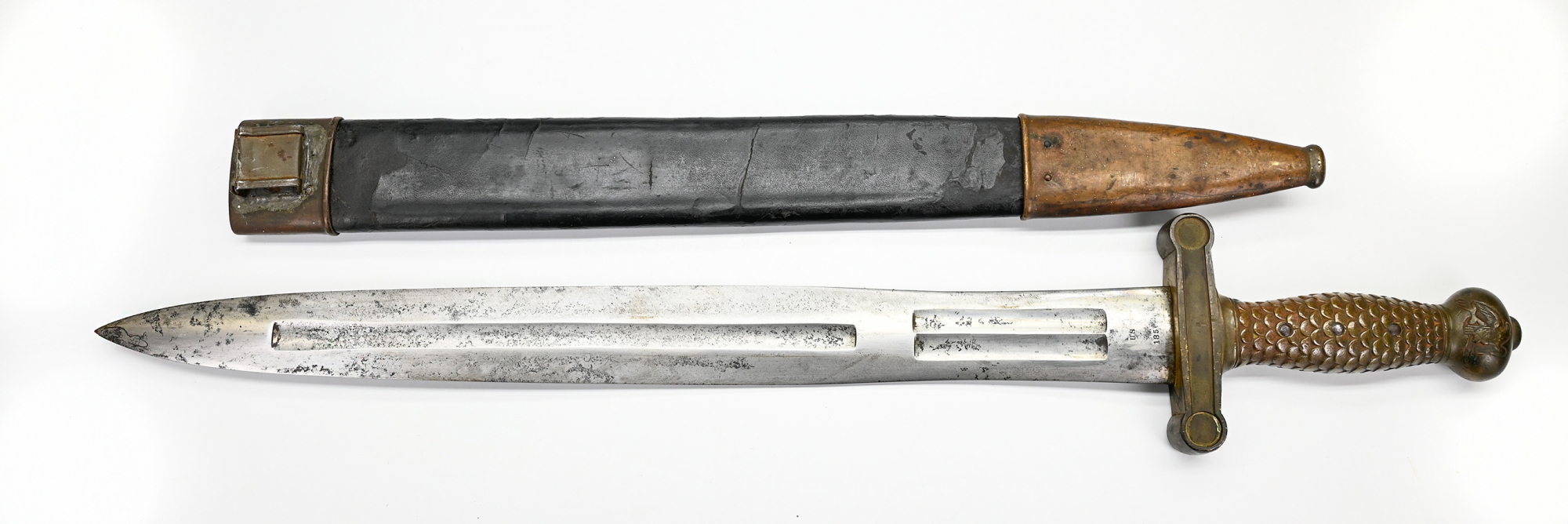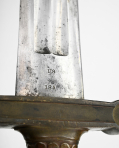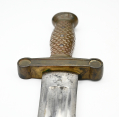site search
online catalog
CONFEDERATE USED US MODEL 1832 ARTILLERY SHORT SWORD BY AMES, DATED 1856

$2,950.00
Quantity Available: 1
Item Code: 2022-2377
Shipping: Determined by Method & Location of buyer
To Order:
Call 717-334-0347,
Fax 717-334-5016, or E-mail
This is a nice example of the US regulation Model 1832 short sword with its scabbard that shows not only some of the changes in the marking of these swords over time, but also a very Confederate alteration of the scabbard throat so that it could be carried simply on a regular waist belt rather than having to use a short sword belt or employ a separate belt frog.
This sword was among the new standardized patterns adopted by the U.S. Army between 1832 and 1834 and was modeled on the French 1816 pattern for artillerymen on foot, but in U.S. Army usage was designated also for infantry sergeants and likely carried by musicians as well, until relegated to heavy (foot) artillery use with the introduction of the 1840 sword patterns. It was conceivably useful for cutting dead artillery horses out of their harness on the battlefield, clearing fields of fire, or last-ditch personal defense, but it was an impressive sword in any case, looking like the ancient Roman gladius, and was a good seller for Ames with significant numbers going to fraternal organizations, militia units, and states by direct purchase or, under the 1808 “Act for arming the militia,” by request from the U.S., which Ames encouraged as part of his marketing. These show up in the hands of militia units serving not just as artillery, and during the Civil War are known to have been issued as stop-gap measures even to some navy personnel in lieu of cutlasses- even by federal forces: one came up off the USS Cairo.
This one is dated 1856, US inspected, and would have been part of the August 1855 contract for 1,000 swords of this pattern, which were delivered July 25, 1856. (The next US contract was not until 1858.) Its markings reflect some changes that took place since the first deliveries of the pattern. The blade address changed after the death of N.P. Ames; the 1855 and 1856 dated examples of this pattern use an oversize block letter die stamp for the address; both the eagle and “United States” stamp are no longer used on the blade; and, the “ORD” stamp is no longer used on the brass. One side of the ricasso is stamped US / JH / 1856, below which, in the channel of the crossguard is another JH stamp (subinspector Joseph or James Hannis.) The other side of the blade is stamped AMES MFG CO / CHICOPEE with the centers of the stamps rubbed. Below that in the crossguard channel is a very clear the R.H.K.W. stamp in smaller letters of chief inspector Robert Whitely.
The blade has a good point and edge with no nicks, with smooth metal a muted silver in color with scattered gray spots. The hilt has a nice untouched patina, showing some wear to the eagle in the pommel from handling over the years and slightly lighter tone to the grip feathers, also from natural handling. The scabbard is very good, with some expected loss to the finish at the top and bottom flats on the side with the belt loop and some loss along the edges, again- natural points where one grasps the sheathed sword. The patina of the scabbard mounts and sword hilt match. The grip shows a little lighter as is natural from handling.
The coolest thing about this sword is crude belt loop that was soldered to the upper mount in place of the original button fastening stud. That stud buttoned into the integral frog of the short sword belt, or could have engaged a separate, floating belt frog. The loop is a simple alteration requiring no special belt or separate frog and permitting its wear on a plainer, generic waist belt. The loop is made of strip of tinned iron, with the sides folded over and the strip then bent and overlapped to form a rectangular belt loop that was then crudely soldered to the throat. This meant the scabbard side originally facing out would be worn against the body, likely explaining some of the loss to the finish on that side. The loop is certainly not any U.S. alteration, far too crude for even most frugal militia unit, and matches the style seen on many Confederate made tinned iron scabbards, making it a great example of CS improvisation and resourcefulness in arming its troops.
This would make a really interesting addition to a collection of Confederate Bowie and side knives. [sr] [ph:m]
~~~~~~~~~~~~~~~~~~~~~~~~~~~~~~~~~~~
THIS ITEM, AS WITH ALL OTHER ITEMS AVAILABLE ON OUR WEB SITE,
MAY BE PURCHASED THROUGH OUR LAYAWAY PROGRAM.
CLICK HERE FOR OUR POLICIES AND TERMS.
THANK YOU!
Inquire About CONFEDERATE USED US MODEL 1832 ARTILLERY SHORT SWORD BY AMES, DATED 1856
For inquiries, please email us at [email protected]
Most Popular
Historical Firearms Stolen From The National Civil War Museum In Harrisburg, Pa »
Theft From Gravesite Of Gen. John Reynolds »
Cavalry Carbine Sling Swivel »
Fine Condition Brass Infantry Bugle Insignia »
featured item
PIECE OF WOOD FROM THE ROOM IN THE WHITE HOUSE WHERE LINCOLN SIGNED THE EMANCIPATION PROCLAMATION
“A piece of wood from the White House where President Lincoln signed the Emancipation Proclamation and usd (sic) as a private office by the Presidents since Jefferson’s time. Presented to Genl. W. J. Palmer by his friend and Comrade Col. W.M.… (945-297). Learn More »













